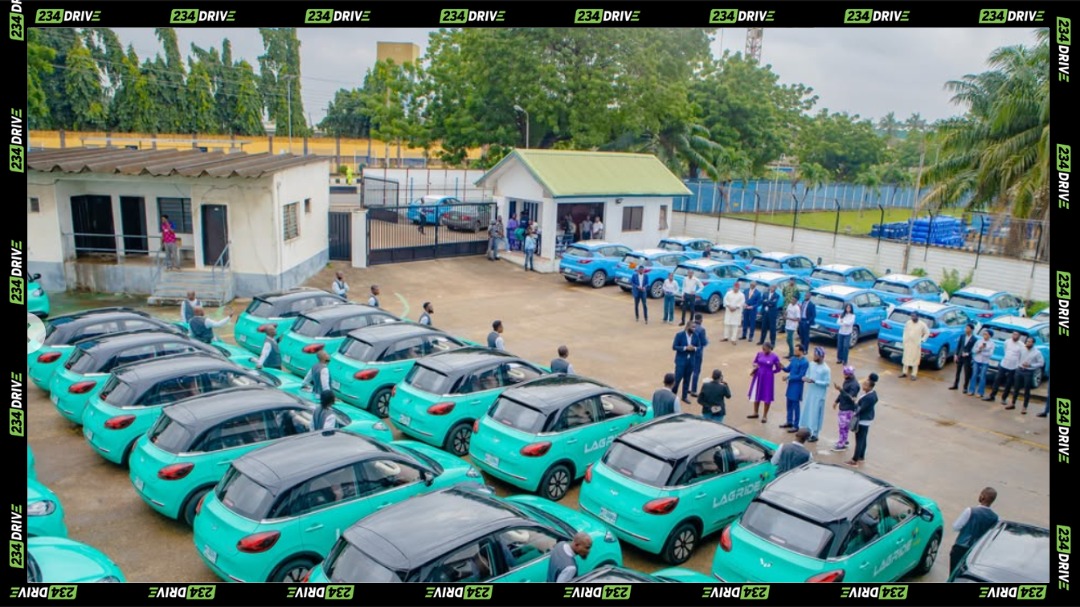A section of LagRide’s newly deployed 100 electric vehicles, lined up and ready to hit Lagos roads for the Ember season rush | Source: LagRide IG account.
As Lagos heads into the hectic Ember season, when festive travel strains the city’s roads and demand for reliable rides surges, LagRide has responded by adding 100 new electric vehicles to its fleet. The government-backed e-hailing platform says the move is a direct push to ease transport pressure, cut emissions, and give drivers and riders more dependable options during one of the busiest travel periods of the year.
The company confirmed the rollout at its Ikeja headquarters on the 20th of September. Executive Director Adeniyi Saliu said the EVs are built for Lagos traffic: they can cover more than 333 km per charge and recharge to full strength in around 30 minutes on rapid chargers. With charging sites now spread across the city, LagRide is tightening routing and driver scheduling to keep cars in service and wait times down.
The business case is simple: lower running costs lift drivers’ take-home pay, while riders get smoother, zero-emission trips. Saliu tied the move to the state’s wider economic and environmental goals—reliability during peak travel, shorter queues, and new jobs in operations, maintenance, and driver programmes.
Maintenance sits at the heart of the LagRide model. The platform runs scheduled preventive servicing, uses data-led diagnostics, fits quality parts, and relies on trained technicians. Ongoing driver education on care, safety, and efficiency underpins the system. The target outcome: fewer breakdowns, longer vehicle life, and consistent service.
Stakeholders and executives at the official unveiling of LagRide’s expanded electric fleet, signalling Lagos’ move toward cleaner and smarter mobility |Source: LagRide IG account.
PR and Communications Lead Ifeanyi Abraham set LagRide’s ambitions against global benchmarks. He pointed to cities like Dubai, where government-aligned e-taxis are known for safety, affordability, and reliability, and said Lagos is moving decisively in the same direction—technology serving people, professional training, and vehicles that match environmental aims.
Capacity is scaling alongside electrification. LagRide is preparing to onboard up to 10,000 additional drivers through a bank-backed vehicle leasing programme before the Yuletide.
New LagRide drivers in training, preparing to join the platform ahead of the Ember period surge with Lagos’ first large-scale EV rollout |Source: LagRide IG account.
To strengthen its workforce, LagRide has also introduced Car Leasing Offers with leading banks, plus “Drive to Own” and “Drive to Earn” paths that help drivers build equity while they work.
This trend isn’t limited to Lagos. In Ebonyi, the state launched EBOCAB (although not an EV initiative), a ride-hailing platform aimed at cutting crime, generating revenue, and creating youth jobs through round-the-clock mobility in Abakaliki and beyond.
While states like Ebonyi chart their own models, for LagRide commuters, the shift promises quieter journeys and more reliable rides. Drivers benefit from lower operating costs and clearer routes to ownership, while Lagos itself gains a system designed to scale responsibly—cutting emissions and improving daily mobility.
Across Nigeria, other green transport ideas are gaining ground. Foltï Technologies’ eDryv, the country’s first solar-powered EV ride-hailing service, highlights the growing appetite for sustainable mobility.
It remains unclear if LagRide will soon allow commuters to specifically request electric vehicles in-app—but the momentum suggests that such a step may follow. As the city embraces cleaner rides, the bigger question becomes: would you be willing to ditch your car and choose an EV-powered LagRide for the sake of Lagos and its environment?










